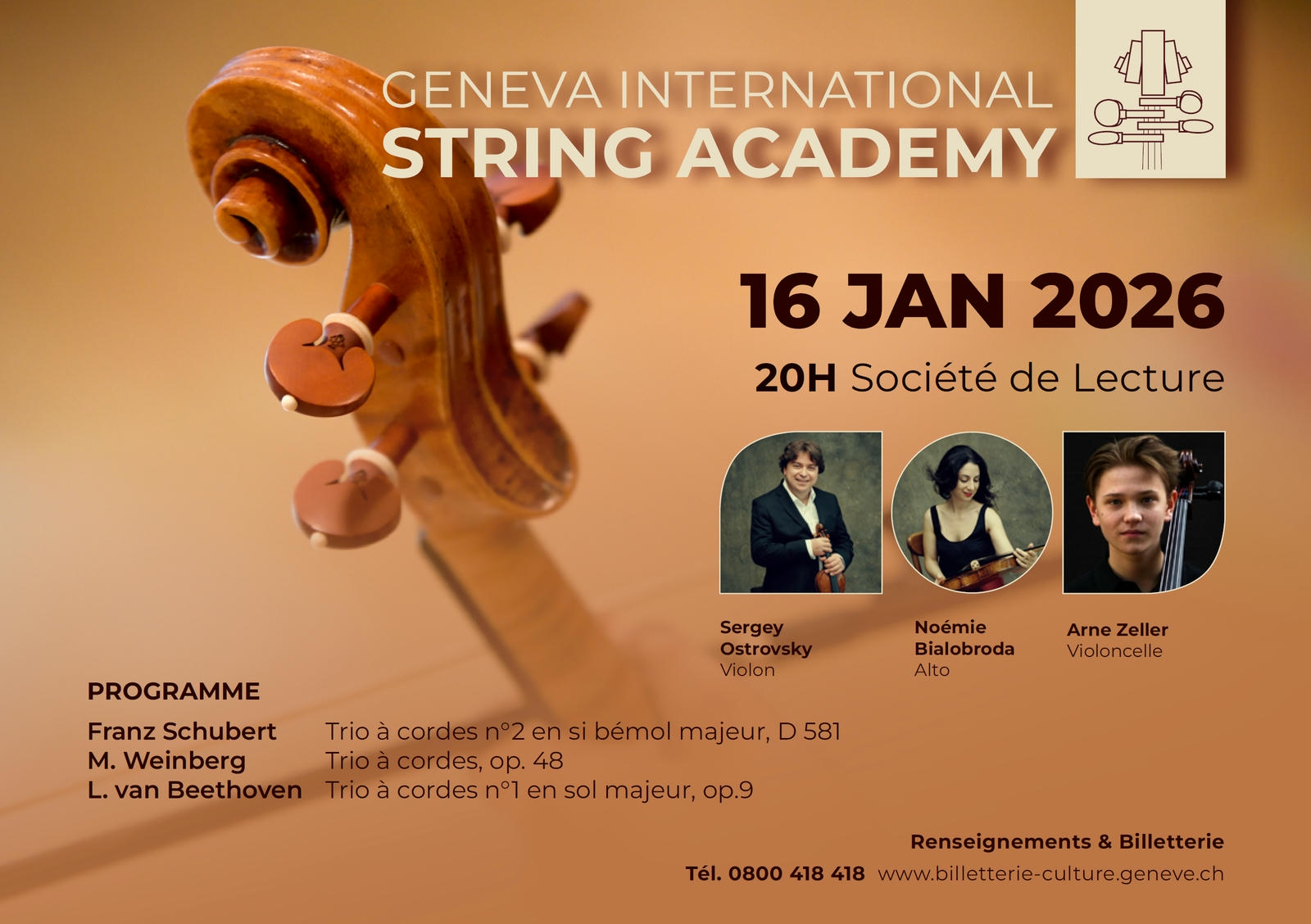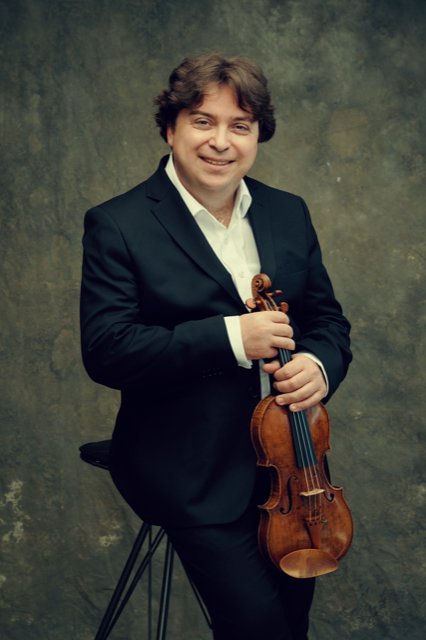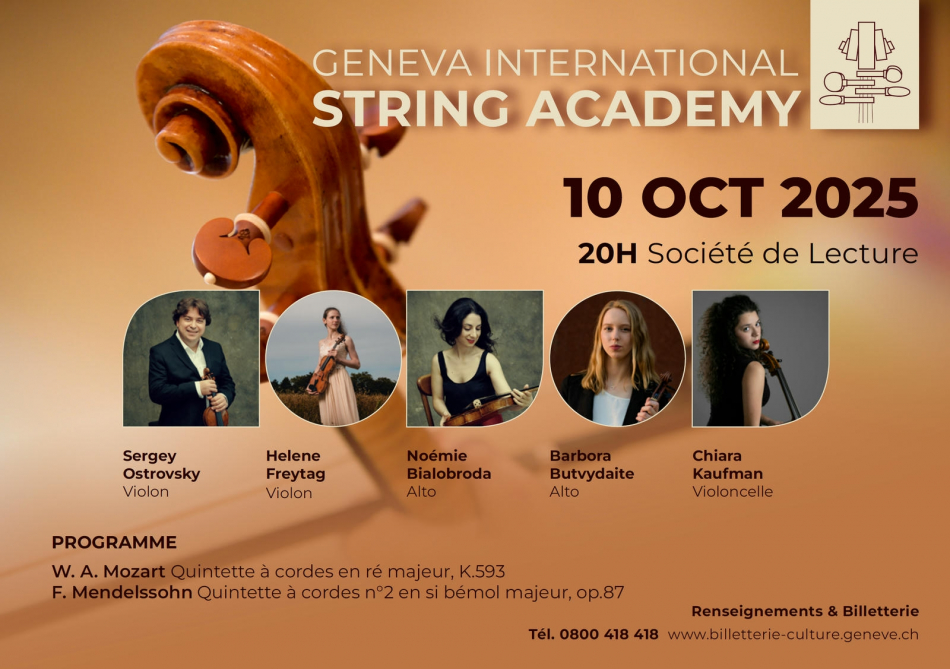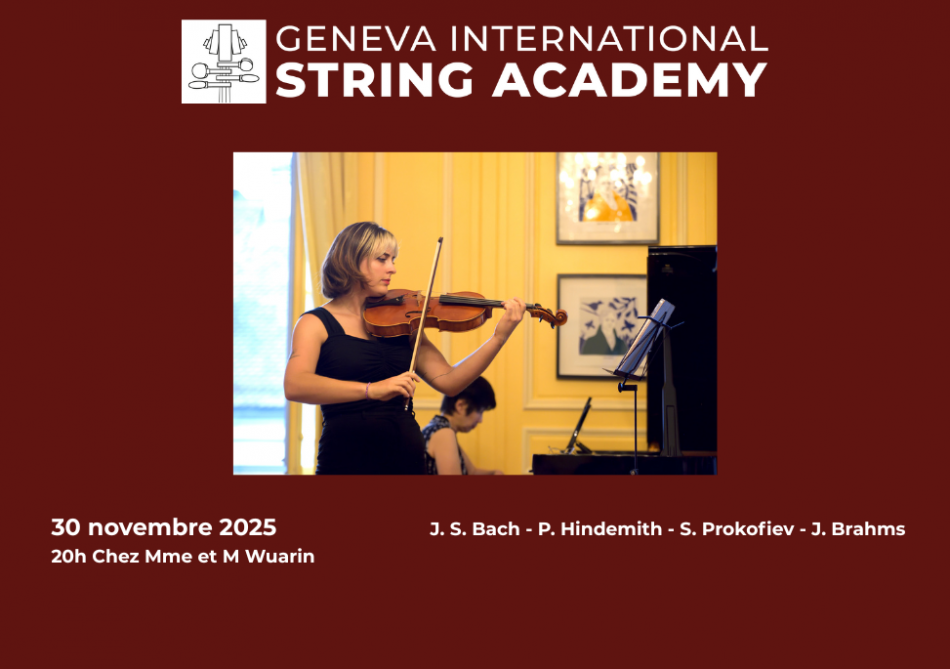Friday 16 January 2026 | 20h00
Société de Lecture

Friday 16 January 2026 |
20h00
Trios Beethoven, Schubert and Weinberg
Société de Lecture
Ticket Information
| Plein Tarif | CHF 30 |
|
Tarif réduit Tarif réduit: pour les membres de l'association GISA, membres de la SDL, chômeurs, AVS-AI | Gratuit pour les moins de 13ans |
CHF 20 |
| Étudiants | CHF 10 |
Three composers, three eras, three perspectives on the intimate.
The string trio, a formation pared down to its essence, offers here its purest power: that of dialogue.
Three voices, three breaths that listen, contradict, and meet each other, like the faces of a shared humanity across time.
With Beethoven, everything begins with conquest: fire, will, the promise of a new world. With Schubert, the light becomes gentler, more inward: a song of the heart, a glance toward the ephemeral. And in Weinberg’s trio, it is the voice of the twentieth century that rises: intimate, profound, full of memory and resilience.
From classical clarity to modern fervor, this program traces an invisible thread — one of emotion that spans the ages and continually connects us to the most human part of music.
The artistic directors of the Geneva International String Academy, Sergey Ostrovsky and Noémie Bialobroda, are joined by Arne Zeller, a former student of the academy in 2023 and 2024 and winner of the 1st prize at the Budapest International Cello Competition 2025, to share with the audience the full richness and emotion of their music.
PROGRAMME
Duration: approximately 100 minutes including intermission
Sergey Ostrovsky - violin, Noémie Bialobroda - viola, Arne Zeller - cello
Franz Schubert (1797 - 1828)
String Trio n°2 in B-flat major, D 581 (1817)
I. Allegro moderato
II. Andante
III. Menuetto
IV. Allegretto
Written at the age of twenty, this trio exudes the freshness and grace of the young Schubert. Mozart’s influence is evident, yet already his singular, tender, and luminous voice emerges, marking him as a poet of melody.
The four movements unfold with Viennese elegance: a charming Allegro moderato, a dreamy Andante, a Menuetto with a folk-like character, and a final Rondo that soars with quiet joy.
Beneath this apparent simplicity lies a world of whispers, light, and confidences. Three instruments speak softly to each other, like three friends sharing the secrets of their souls on a clear morning.
Mieczysław Weinberg (1919 – 1996)
String Trio, op. 48 (1950)
I. Allegro con moto
II. Andante
III. Moderato assai
Composed in Moscow in 1950, during a period of intense political and personal tension, Weinberg’s String Trio Op. 48 is among his most intimate works. The three voices seek clarity within shadow. The writing, dense and compact, unfolds in a grave atmosphere, understated yet deeply emotional.
The first movement, Allegro con moto, opens with restrained, almost anxious energy, each motif seeming to weigh its words before speaking. The second, Andante, of suspended beauty, reveals the composer’s full expressive depth: a solitary melody rises, fragile but persistent, like a thread of hope. The final movement, Moderato assai, closes the work in an atmosphere of peaceful resignation, a twilight light after the storm.
Beneath this formal sobriety lies overwhelming intensity: Weinberg whispers the memory of a scarred century, yet also the stubborn faith in humanity. It is music that does not shout; it remembers, consoles, and endures.
Ludwig van Beethoven (1770 - 1827)
String Trio n°1 in G major, op.9 (1799)
I. Adagio – Allegro con brio
II. Adagio ma non tanto e cantabile
III. Scherzo. Allegro
IV. Presto
In this youthful masterpiece, Beethoven transforms the string trio into a canvas of contrasts and discovery. The music sparkles with clarity, yet beneath its elegant surface lies a restless, questioning spirit.
In this first trio, rhythmic vigor and clarity of discourse combine with striking inner intensity. The Allegro con brio opens with youthful energy, the Adagio ma non tanto unfolds a noble serenity, the Scherzo surprises with audacity, and the Finale concludes with a breath of freedom.
Here, Beethoven’s inventive mind and passionate heart are already evident: he pushes the boundaries of classical form, blending elegance with intensity, humor with gravity, and tradition with daring innovation. This trio is a celebration of discovery — a glimpse into the world of a composer on the verge of greatness.
Biographies
Related Events
WA. Mozart : Quintette à cordes en ré majeur, K.593
F. Mendelssohn : Quintette à cordes n°2 en si bémol majeur, op.87
Sergey Ostrovsky - violon, Helene Freytag - violon, Noémie Bialobroda - alto, Barbora Butvydaite - alto, Chiara Kaufman - violoncelle
J.S. Bach : Prélude de la suite en ré majeur pour violoncelle BWV 1012
P. Hindemith : Sonate pour alto et piano n°4, op. 11
S. Prokofiev : Roméo et Juliette - Prélude, Juliette jeune fille, Scène du balcon, transcription pour alto et piano
J. Brahms : sonate pour alto et piano n°2 en mi bémol, op. 120
Theresa Hořejší - alto
Simon Adda-Reyss - piano
L. van Beethoven : Sonate pour violoncelle et piano n°3 en la majeur, op. 69
R. Schumann : Adagio et Allegro pour violoncelle et piano en la bémol majeur, op. 70
J. Brahms : Sonate pour violoncelle et piano n°2 en fa majeur, op. 99
Henriette-Luise Knauer - violoncelle, HunJu Sohn - piano
D. Chostakovitch : Piano Quintet in G minor, Op. 57
F. Schubert : String Quintet in C major, D. 956
Sergey Ostrovsky - violin, Eva Kobor - violin, Noémie Bialobroda - viola, Jonathan Gerstner - cello, Auguste Rahon - cello, Ekaterina Bonyushkina - piano
C. Debussy : Sonata for Violin and Piano in G minor
A. Glazounov : Three Pieces from ‘Raymonda’ Op.57
B. Bartók : Rhapsody for Violin and Piano No.1
S. Prokofiev : Solo Violin Sonata
C. Franck : Sonata for Violin and Piano in A major
Andrew Samarasekara - violon
Svitlana Kosenko - piano







